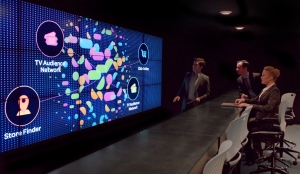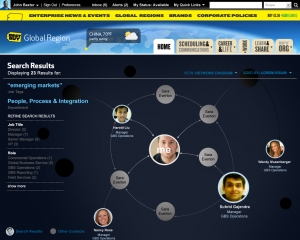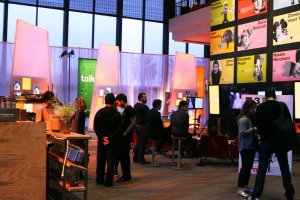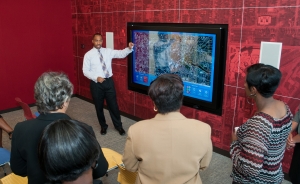Face to Face to Face: How to Re-Think Your Innovation Experience
Posted July 30, 2013
We all know that innovation is critical to growth, which has led to the global trend in creating Corporate Innovation Experiences. They go by various names – Innovation Centers, Idea Labs, Test Sites, Executive Briefing Centers, Business Incubators, etc. What’s changing about these spaces is how they need to work and what they need to accomplish. They can no longer just be static galleries displaying the artifacts of innovation. They need to become more dynamic, participatory, inspiring and networked.
If your Innovation Experiences seem stuck, or you are creating one for the first time, ask yourself the following questions to retool them for long-term success:
Is it social?
How are you stimulating face-to-face interaction?
Innovation is social, and everything social is driven in part by face-to-face interaction. Whenever we work on designing an innovation experience for companies, we strive to integrate digital and physical environments into seamless social experiences. As we tell our clients, “Face to face is the highest bandwidth.” We look for what must be shared by a group of people in the same place at the same time and ask, “How do places of human warmth and gathering enter into the equation?” Much energy is being put into online platforms for innovation and collaboration. These power tools harness the collective imagination of large groups and have proven effective in solving some difficult challenges. Yet, if the results of this collective online energy are not grounded, they become difficult to comprehend at human scale. Online activities need anchor points in the real world – intersections of human activity where the “high-bandwidth” qualities of face-to-face collaboration counterbalance the massive “low-bandwidth” engagement that online interactions afford. A network of face-to-face places devoted to innovation is a strong complement to a network of digital innovation tools. Woven together, they create a powerful holistic network of innovation that functions at both human and global scale.
Is it cross-functional?
How are you breaking down internal barriers?
 Silos are deadly to innovation. Centers of face-to-face interaction can be a key part of internal communications efforts to focus the organization on the problems it has set out to solve. These spaces can be active forums for cross-functional conversation around the ideas that are coming up through the organization. The richest insights come from unexpected dialogs between people that operate at different levels in the company. The Innovation Experience creates a space and time for the organization to listen to itself and learn how to be better. The space wants to feel like a workshop, where employees roll up their sleeves and work together to develop ideas. The more actual work is being done in these spaces, the better the experience — because it moves from being simulated to being authentic, and everyone feels better about putting time and energy into it.
Silos are deadly to innovation. Centers of face-to-face interaction can be a key part of internal communications efforts to focus the organization on the problems it has set out to solve. These spaces can be active forums for cross-functional conversation around the ideas that are coming up through the organization. The richest insights come from unexpected dialogs between people that operate at different levels in the company. The Innovation Experience creates a space and time for the organization to listen to itself and learn how to be better. The space wants to feel like a workshop, where employees roll up their sleeves and work together to develop ideas. The more actual work is being done in these spaces, the better the experience — because it moves from being simulated to being authentic, and everyone feels better about putting time and energy into it.
Is it open to partners?
How are you encouraging B2B co-creation and open innovation?
Innovation isn’t an internal affair. Some of the best ideas are sparked by solving problems and co-creating with partners — so design a space that works for them, too. Co-creation sessions can run the gamut from initial test-the-water conversations to all-out design charrettes where partners hash out innovative directions to pursue. Innovation Experiences can also be powerful incubators. Many corporations from GE to Unilever, are seeing the value in connecting with individuals and startups to reignite the entrepreneurial spark within their organizations. Innovation spaces can be used to orchestrate open-innovation sessions, stage hackathons and get fresh perspectives by putting tough challenges to outsiders.
Did you invite your customers?
How are you collaborating with your customer community?
Customers are not just consumers anymore. They are active partners in the well-being of your organization and have a POV about innovation. Tap into this. Invite customers into your Innovation Experiences on a regular basis, because your best customers care as much as you do. Innovation Experiences are natural testing sites where you can put new ideas in front of them and get their feedback. Think of it as having an on-going focus group session feeding your innovation efforts. Customer-facing innovation centers can also be catalysts for community development. They can educate the local community about the skills and mindset valued by the organization. They are also places to bring your Social Responsibility programs to life, giving them a tangible stage to create awareness about them. Ideally, you can use these spaces to work with your customers on programs that make the local community stronger and better.
Is it networked?
How are you building an evolutionary experience?
 The most successful strategies will move Innovation Experiences from static displays of innovation history to dynamic platforms that evolve and change through participation. In the network of innovation, some nodes may need to be exclusively internal, some may be just for partners and others may need to be exclusively for customers. The biggest win, however, is when you create contexts for crossover interactions between all your stakeholders. Innovation comes from the disciplined pursuit of serendipity, and the big innovations will come from teams. The larger and more diverse the team, the greater the chances for serendipity. When customers, partners, employees and community members talk and work together, the potential for innovation soars. Face to face is a good start. Face to face to face to face is even better.
The most successful strategies will move Innovation Experiences from static displays of innovation history to dynamic platforms that evolve and change through participation. In the network of innovation, some nodes may need to be exclusively internal, some may be just for partners and others may need to be exclusively for customers. The biggest win, however, is when you create contexts for crossover interactions between all your stakeholders. Innovation comes from the disciplined pursuit of serendipity, and the big innovations will come from teams. The larger and more diverse the team, the greater the chances for serendipity. When customers, partners, employees and community members talk and work together, the potential for innovation soars. Face to face is a good start. Face to face to face to face is even better.




Join The Conversation